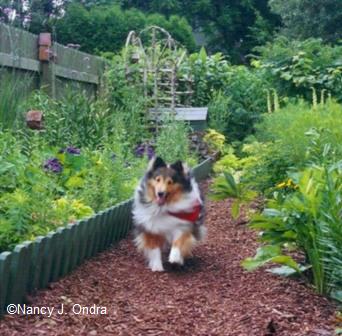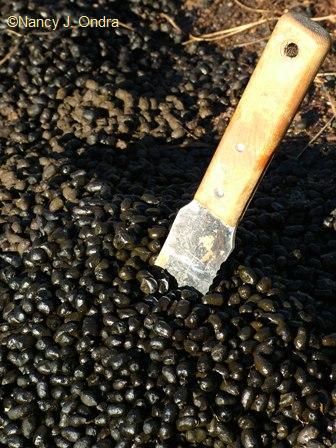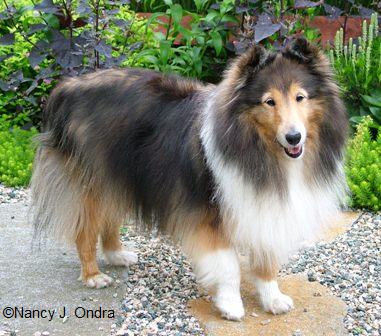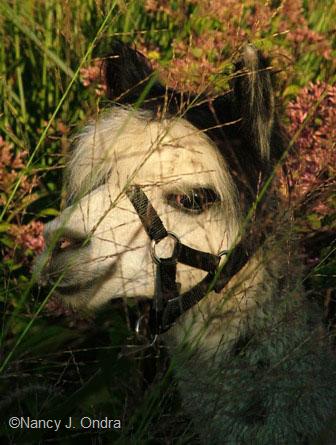Back in December, we talked about children in the garden, but they’re not the only ones who share our outdoor spaces. If you’ve spent any time at all traipsing around the garden blogdom, you’ve seen that pets often play as big a role in our gardens as our plants do. Big dogs, little dogs, and all kinds and colors of kitties: seeing photos of these furry friends enjoying their family gardens is sure to elicit a smile. You can find some less common pets, as well, including chickens, ducks, bunnies, goats, sheep, horses, and alpacas. I think Kim at The Inadvertent Farmer may get the prize for the most unusual pet: she has a camel!
 So, to those of you who enjoy spending time outdoors with your pets: Have you made any design changes to your garden to accommodate them? For me, the answer is emphatically yes, particularly for my previous garden. In that case, it wasn’t so much a choice as a survival strategy: My dear Sheltie puppy had lots of energy, and she’d invent games if I didn’t do it first. One of her favorite pastimes was running laps around the garden. To direct her route and help to keep all the bark mulch from getting kicked into the beds, Mom built over a hundred feet of mini-picket fences, which made a cute and practical edging. Other modifications included a variety of hoops, hurdles, and ramps she could (and did) use to jump or climb over plantings instead of run through them. High design it was not, but it saved a lot of heartache and gave her plenty of ways to wear herself out.
So, to those of you who enjoy spending time outdoors with your pets: Have you made any design changes to your garden to accommodate them? For me, the answer is emphatically yes, particularly for my previous garden. In that case, it wasn’t so much a choice as a survival strategy: My dear Sheltie puppy had lots of energy, and she’d invent games if I didn’t do it first. One of her favorite pastimes was running laps around the garden. To direct her route and help to keep all the bark mulch from getting kicked into the beds, Mom built over a hundred feet of mini-picket fences, which made a cute and practical edging. Other modifications included a variety of hoops, hurdles, and ramps she could (and did) use to jump or climb over plantings instead of run through them. High design it was not, but it saved a lot of heartache and gave her plenty of ways to wear herself out.
Another question for my fellow pet owners: Do you worry about potentially poisonous plants, and has that influenced your plant choices? And if so, who do you depend on for advice about which plants might be a concern? This ASPCA page appears to be an excellent source of information on frequently encountered indoor and outdoor plants that are and are not toxic to dogs, cats, and horses. Those of us with other critters have to seek elsewhere for lists relating to our particular pets. Believe me, there aren’t many lists of alpaca-safe garden plants! I’ve tried to err on the side of caution by sticking mostly with ornamental grasses, willows (Salix), and daylilies (Hemerocallis) along Duncan and Daniel’s pasture fences. And when “the boys” and I cut through the garden on our way out for or back from a walk, you can bet I keep a close eye on them so they don’t nibble on anything questionable.
 Speaking of what our critters are eating: well, what goes in must come out. One of my favorite things about my boys is the never-ending supply of “paca poo,” which has proven to be a fantastic soil amendment. (I wrote about the delights of alpaca manure a while back in Non-Natives in the Garden.) Those of you with chickens, horses, and other livestock-type pets probably feel the same about the benefits of your own critters’ by-products. Care to share how you use their manure in your garden? Those of you with dogs and cats have a different issue, as pointed out in Fran’s recent post The Scoop on Dog Poop. How do you deal with keeping your lawn and garden poo-free?
Speaking of what our critters are eating: well, what goes in must come out. One of my favorite things about my boys is the never-ending supply of “paca poo,” which has proven to be a fantastic soil amendment. (I wrote about the delights of alpaca manure a while back in Non-Natives in the Garden.) Those of you with chickens, horses, and other livestock-type pets probably feel the same about the benefits of your own critters’ by-products. Care to share how you use their manure in your garden? Those of you with dogs and cats have a different issue, as pointed out in Fran’s recent post The Scoop on Dog Poop. How do you deal with keeping your lawn and garden poo-free?
Have you designed part of your garden specifically for your fuzzy or feathered companions? One project that comes to mind is Steve’s high-class chicken coop, which he wrote about in Where Elvis Lives. I’m sure others of you have equally creative pet-related plantings and structures. Or, what about a memorial garden for the dearly loved pets that have passed out of your life?
Lest we get too sentimental, let’s remember that life with pets in the garden isn’t always fluffy clouds and rainbows. Besides the poo problem, there’s a lot of potential for plant damage from digging and general romping. Care to share your strategies for keeping your pets out of places you don’t want them to be? How about etiquette suggestions you’d like to give others who bring their pets to your place?
If you’re new to the GGW Design Workshops, here’s how it works: Write a post on anything related to pets in the garden on your own blog and give us the link below, or simply leave a comment if you don’t want to do a separate post. If you’ve written about the topic in the past, those links are equally welcome; it’s not necessary to create a new post to participate.
At the end of the month, I’ll gather all of the links into one summary post for easy reference. If you’re interested in checking out previous GBD Workshops, you can find them here:
Paths and Walkways
Fences and Walls
Arbors and Pergolas
Color in the Garden
Container Plantings
Front-Yard Gardens
Stone in the Garden
Decks, Porches, and Patios
Garden Whimsy
Trellises and Screens
Water in the Garden
Sheds and Outbuildings
Incorporating Edibles
Kids in the Garden
Labeling and Record-Keeping
Don’t forget that you’re all welcome to go back and add links to these older posts. Pam at GardenDesigns+More, for instance, recently added a link to last year’s Color in the Garden topic. You’d be amazed at how many visitors those archived GBDW posts still get.
As a final note: I haven’t forgotten that wild creatures are just as important as our domesticated pals. Next month, the GBDW topic will be about wildlife in the garden: the good (birds, butterflies, and beneficials) and the bad (rabbits, deer, and other four-footed menaces). Now you know!



